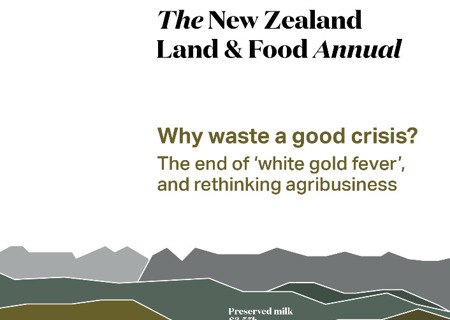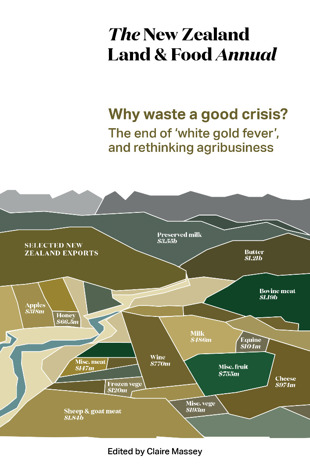I grew up on a dairy farm in New Zealand. Fifty years ago, the conversations I overheard in my parents’ kitchen were about droughts, the difficulty of getting young people into farming as a career, and — the major concern for them at the time — the threat of ‘lifestyle blocks’ encroaching on what they regarded as productive land. I recall Britain’s entry into the European Economic Community (EEC) and remember my father’s implacable position: that the system of supplementary minimum prices had to be dismantled if New Zealand was going to prosper in a new environment where being competitive internationally was the key to survival.
It was the same background as that of thousands of New Zealanders, families in which the daily conversations focused on how best to earn a living from the land in a way that ensured that the next season would be protected and future value preserved for another generation. The talk in homes around the country was of threats to their way of life and how to respond, and their context was international — though bounded by what was then called ‘home’, which for many New Zealanders was the United Kingdom. They looked for ways of dealing with the threats they saw coming, and they responded in a way that was so uniquely New Zealand it developed its own name: Number 8 wire. They understood the farm as a system with complex inputs and outputs and they used the available technology to manage the results.
On today’s farms, so much of this picture has changed. The horizon has shifted, with the rapid increase in free trade agreements giving New Zealand producers access to markets that a previous generation would have only dreamed of. What we farm has changed, too, as new markets have opened up. Our domestic base now accommodates the ethnic diversity that makes up the new New Zealand, and throughout the country growers meet the demands of Kiwi travellers returning home having experienced new foods and cuisines.
Demand for new food emerges even from those who have not left the country; between television and the internet, it’s hard to escape a cooking show with its inevitable exposure to at least one new ingredient. At the same time, the Information Age allows us to engage with the world in a way that would have been impossible for the previous generation. A quick Google search provides data on the most valuable food exports of any country you care to name — and our access to daily news from around the globe offers an unimagined level of information. Where once GDP was practically the only indicator of a country’s performance, nowadays there is an index for almost any dimension that can be thought of.
Not only have we changed, but as a nation we have also matured. The iwi settlement process that began in the 1980s has left us with a foundation for greater participation in the country’s prosperity than even before. As the Māori economy expands, and its key enterprises find their way in the international market, the whole of New Zealand benefits.
As different populations find their place in the new New Zealand, new voices enter the conversations about issues that affect us all; there is a different discussion about natural resources and their ownership and use than that in which my parents would have participated. The focus in the week during which I wrote this was on a crucial question in relation to water: Can it be owned? And, if not, what are the implications for companies that seek to commercialise it as a consumer product?
Water has also been the main focus for another item of debate in recent years and months: Who gets the right to decide on the most appropriate way to use it when multiple users are involved? An example of this debate is when recreational water users and producers work through the issues around their differing expectations of accessing a valuable resource.
A similar debate, again with water at its heart, is a sub-theme of the current discussion about the dairy industry. While on one level our attention is focused on the state of the global markets, underneath this is another, more fundamental question: Is the level of dairying in New Zealand a good thing at all? At present this debate is covert — or not fully in the open — but a close look at the language used in the conversations and forums around the county is instructive. If I may summarise it in broad brushstrokes, those opposing increased dairying talk about ‘intensification’ and ‘factory farming’, whereas the proponents talk about ‘optimisation’ and careful resource management.
[...]
In this volume, the first in an intended annual publication, you will find chapters that pose questions and encourage debate. Some have been written by researchers and relate closely to long-running research programmes; others are based on an industry perspective and a personal viewpoint of the way forward for New Zealand. Farmers, bankers, scientists, economists, manufacturers and exporters are all represented here. They address the subtitle Why waste a good crisis? in some way, asking: Can we use the current situation facing the dairy industry to stimulate action across New Zealand that will shift the nation’s earnings while maintaining our standard of living? In some areas the way forward will appear clear, but in others there are debates about the best options. In some areas the question is one of timing. While there is an increasingly strong call to limit the way in which stock effluent flows into waterways, for example, the science is still developing. At present we can simply limit this impact, not remove it completely.
The argument we make in this volume is that change does need to occur if our land and food sectors are to thrive in the next hundred years. The suggestion is that the crisis provides us with an opportunity to talk about the action that needs to be taken across all sectors and in all parts of New Zealand — by consumers as well as producers.
This notion will be given short shrift by some — especially those at the pointy end of the crisis, whose livelihoods and whānau are directly affected by the current low prices in dairy. But, with no disrespect to these individuals, this is a serious question for all of us to answer and to deal with; it can’t be confined to those currently in the firing line. If New Zealand is to be prosperous in the future, any opportunity we have to solidify a foundation from which to do so must be taken.
Crises are never fun for those in the maelstrom, and ‘a good crisis’ can only be appreciated once it has passed. The way in which all New Zealand can share in the pain is to become part of the solution and look for the way out. This book is for the thousands of New Zealanders who are prepared to engage in this challenge.
The New Zealand Land & Food Annual is published by Massey University Press and available for purchase here.


